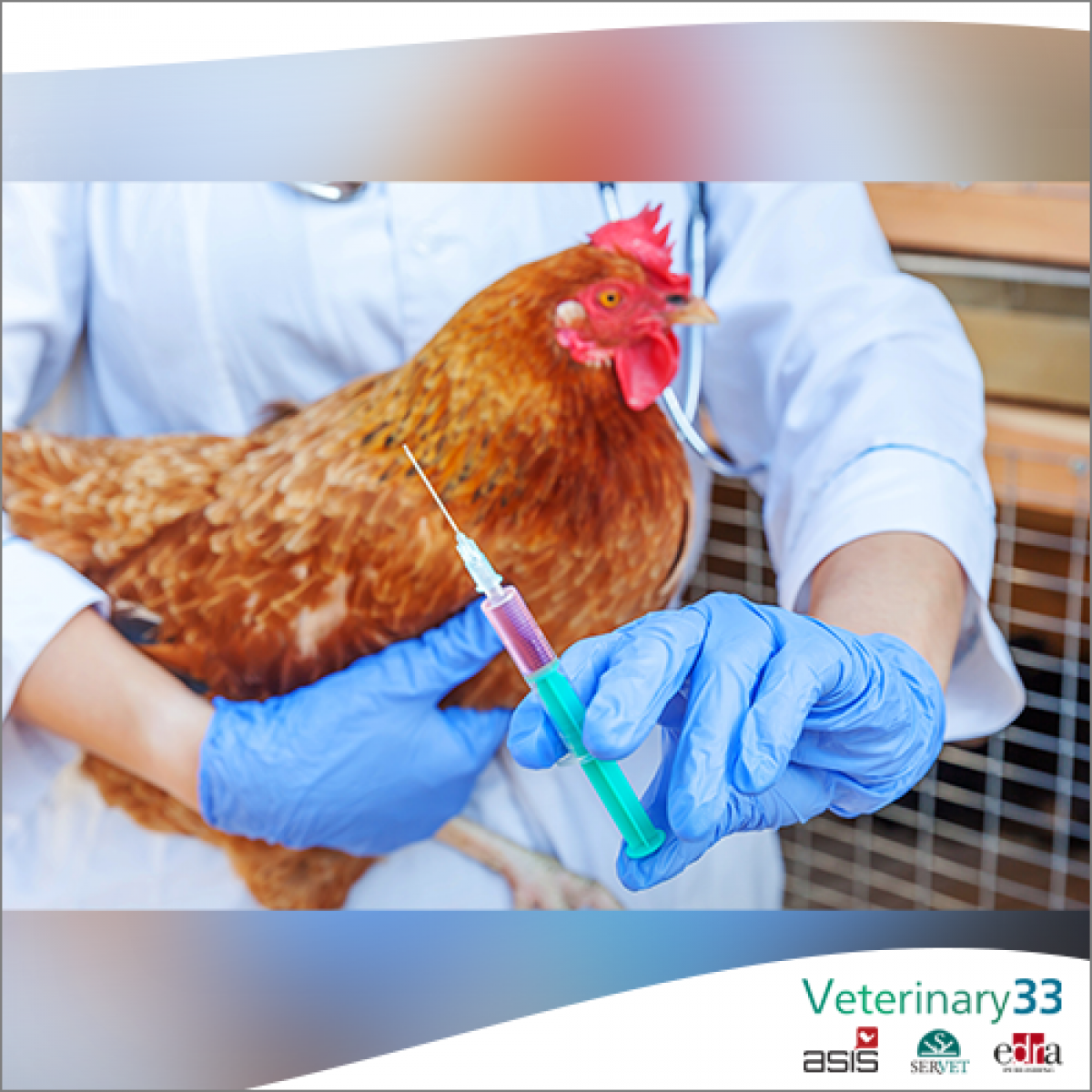New Marek's Disease Vaccine
Marek’s disease is a common viral infection that affects chicken flocks, and costs the global poultry industry approximately $2 billion every year. No effective treatment exists for the condition, and vaccination and strict sanitation are the central strategies for preventing and controlling Marek’s disease. The virus is constantly evolving, and has been known to break through previously protective immunity levels. In April 2021, Boehringer Ingelheim Animal Health launched a new vaccine against Marek’s disease available in the United Kingdom and European Union countries.
Marek’s disease etiology and transmission
Marek’s disease (MD) is a member of the genus Mardivirus, which has three serotypes. Gallid alphaherpesvirus 2 (MD serotype 1) represents all virulent Marek’s disease virus strains and has four pathotypes, designated as mild (m), virulent (v), very virulent (vv), and very virulent plus (vv+). Gallid alphaherpesvirus 3 (MD serotype 2) and Meleagrid alphaherpesvirus 1 (turkey herpesvirus, MD serotype 3) represent avirulent virus strains, and are commonly used to make vaccines against Marek’s disease.
The virus matures to a fully infective form in the feather follicle epithelium, and is released in the environment where the virus is highly contagious and readily transmissible among chickens. The virus can survive for months in poultry house litter and dust, so once the virus is introduced to a chicken flock, bird-to-bird infection spreads quickly, and infected chickens are carriers for long periods. Prior vaccination can reduce, but not prevent, viral shed.
Marek’s disease signs and diagnosis
The signs depend on several factors, including the viral strain and dose, age at exposure, maternal antibody, host gender and genetics, vaccine strain and dose, and environmental factors, such as stress. Some infected cells undergo neoplastic transformation, forming characteristic lymphoid neoplasms. Other disease syndromes include:
- Transient paralysis — Some chickens become ataxic for several days, and then recover.
- Early mortality syndrome — Young chicks who are affected may die suddenly.
- Cytolytic infections — The virus can change the affected cell’s morphology, causing the cell’s death.
- Atherosclerosis — The virus can cause fatty material plaques to accumulate inside the chicken’s arteries.
- Persistent neurologic disease — Some chickens remain ataxic, or become paralyzed.
Marek’s disease is typically diagnosed using history, clinical signs, gross pathology, and histopathology. Enlarged nerves and lymphoid tumors suggest Marek’s disease. The vagus, brachial, sciatic, and various peripheral nerves become enlarged and lose their striations. Lymphoid tumors may be seen in various organs, including the liver, spleen, heart, lungs, and kidneys.
Marek’s disease prevention
No effective treatment for Marek’s disease exists, so prevention is key to disease control. Prevention measures include vaccination, strict sanitation, and breeding for genetic resistance.
- Vaccination — Proper vaccine handling during thawing and reconstitution is crucial to ensure the vaccine is effective. Cell-associated vaccines are typically more effective than cell-free vaccines, because they are neutralized less by maternal antibodies. The vaccines are most effective when administered at hatch or in ovo to embryos at the 18th day of incubation, which typically is done by automated technology. Since vaccination became routine, losses from Marek’s disease have been reduced dramatically in broiler and layer flocks, but disease remains a serious problem in some individual flocks, and in selected geographic areas. These problems may be explained by early exposure to very virulent (vv) virus strains. The most widely used vaccines include:
- Turkey herpesvirus — Naturally avirulent Meleagrid alphaherpesvirus 1
- SB-1 or 301 B/1 — Naturally avirulent Gallid alphaherpesvirus 3
- CVI988/Rispens — Attenuated Gallid alphaherpesvirus 2
- Biosecurity — MD resides predominantly in the feather follicle matter contained in dust, so the pathogen is ubiquitous in poultry housing sheds. To prevent viral spread, every dust particle must be removed, including the ventilation inlets, fan shafts, and outside surfaces. Since infected dust can be carried anywhere, areas that don’t house birds, such as office spaces, breakrooms, and bathrooms, should also be thoroughly cleaned.
- Genetic resistance — In 2020, researchers at the University of Edinburgh’s Roslin Institute in Scotland identified specific chicken DNA regions associated with resistance to MD. They also investigated factors that made chickens susceptible to the virus. This information could lead to more precise selective breeding strategies to help prevent MD.
Boehringer Ingelheim’s Prevexxion RN
In April 2021, Boehringer Ingelheim launched Prevexxion RN, a new MD vaccine in the UK and EU. Prevexxion is a chimeric or hybrid vaccine that was developed using innovative design concepts that have shown promise in developing potential vaccines for human diseases, such as yellow fever and Dengue fever. Innovative engineering techniques include:
- Chimeric structure — Chimeric vaccines are created by substituting genes from the target pathogen for similar genes in a safe, but closely related, organism. The new RN1250 Prevexxion RN strain was created by taking the best traits from the three existing MD virus strains, and combining them to create the first hybrid vaccine against MD to provide wider protection in the field, including protection against very virulent MD.
- Long terminal repeat (LTR) insertion attenuation — Attenuation is how a vaccine virus is altered so that the host is not harmed, but immunity is still triggered. Classic MD serotype 1 vaccines are attenuated by passing low virulence strains through cell cultures several times. While each passage reduces the virus’ ability to cause disease in the birds, the process also has the potential to decrease vaccine efficacy. LTRs naturally occur in the genome sequence in many viruses. Since viruses naturally exchange and insert LTRs, advancement in vaccine creation technology employs an LTR insertion process to attenuate the new RN1250 vaccine strain, so the vaccine’s efficacy is not decreased.
These innovative techniques allow Prevexxion RN to provide protection against very virulent MD strains in a way that previous vaccines have been unable to accomplish. Worldwide field and lab experiments have demonstrated the vaccine’s safety and efficacy, and its early, vigorous, and long-lasting protection through the bird’s lifespan.
Boehringer Ingelheim’s Prevexxion RN will help poultry farmers in the UK and EU control and prevent MD in their flocks. Protection against the very virulent virus strains will hopefully prevent excessive losses seen in the past.











List
Add
Please enter a comment